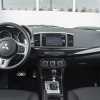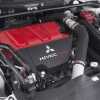The end of an era is upon us. After this year, the Mitsubishi Lancer Evolution will be no more. The model which was first introduced back in 1992 for the Japanese marketplace, was a technological tour-de-force with a turbocharged four-cylinder, all-wheel drive, and a limited slip differential. From there, Mitsubishi would introduce a number of new technologies such as traction control, YAW control, and a dual-clutch automatic. But Mitsubishi hasn’t done much with the Lancer Evolution in the past few years, instead changing its focus to electrics and crossovers. So before the Lancer Evolution heads up to the great parking lot in the sky, we decided to say farewell by driving an MR for a week.
As the name suggests, the Lancer Evolution is based on the Lancer compact sedan. Not a bad place to start since the Lancer is a distinctive looking sedan, despite being the oldest design in the class. From there, Mitsubishi makes some changes with a new grille and hood to improve cooling of the engine. The side boasts new skirts and a set of multi-spoke, lightweight BBS wheels. Towards the back, Mitsubishi fits a rear diffuser and twin exhaust system. MR models get a small lip spoiler on the hood. Those wanting the big wing will need to go with the base GSR model. These changes make the Lancer Evolution a standout in the Mitsubishi lineup.
Moving inside, you can’t help but feel massive disappointment. The Evolution has the same problems as the standard Lancer with cheap feeling and looking plastics throughout the material. You can’t help but question why anyone would spend almost $40,000 if it includes materials like this. At least Mitsubishi did use some better materials on the door panels and fitted a set of Recaro bucket seats up front. The bucket seats provide the right amount of bolstering to keep you and your passenger locked in when driving. The back seat is best used for emergencies as space is very much at a premium.
No matter which trim of the Lancer Evolution you decide to get, it will come with a 6.1-inch touchscreen and Mitsubishi’s FUSE hands-free system, which allows an owner to connect their Bluetooth phone and/or USB device to the vehicle and control them via voice command. I found this system to be somewhat hit and miss as it doesn’t always recognize what you’re saying, even if you are doing it as clear and concise as you can. The touchscreen system is not the most responsive and the interface looks like it came from the Windows 3.1 era.
See the next page for thoughts on the powertrain and handling.
Power comes from a turbocharged 2.0L four-cylinder with 291 horsepower and 300 pound-feet of torque. On my MR tester, a six-speed twin-clutch SST - Mitsubishi speak for dual-clutch automatic - gets all of the power to the wheels. Those who want to feel like they are a part of the machine will want to go for the base GSR model as it gets a five-speed manual. Mitsubishi’s Super All-Wheel Control (S-AWC) gets the power to the road and includes a drive selector mode which changes various settings to provide the best traction for whatever condition you find yourself driving in.
The engine likes to be worked, especially out on a nice bit of curvy road. Step on the accelerator and the power comes on instantly. More impressive is the engine doesn’t seem to lose any of the oomph as it climbs higher in the rev range. The transmission is lightning quick with shifts, and allows the driver to shift via aset of paddles behind the wheel.
But when you decide to drive the Lancer Evolution on daily basis, it falls apart. The dual-clutch transmission seems very confused at low speeds and gives very clunky shifts. I found that if I left a stop with the transmission in second gear, some of these problems were alleviated. But the biggest problem for the Lancer Evolution’s powertrain is fuel economy. The EPA rates the 2015 Lancer Evolution MR at 17 City/22 Highway/19 Combined. I got an average of 17 MPG for the week.
As for the ride and drive, Mitsubishi fits a set of stiffer dampers and springs to improve cornering. You’ll also find a set of massive Brembo brakes to help bring the Lancer Evolution to a short stop. Much like the engine, the suspension shines when driven hard on a curvy piece of tarmac. There is no sign of body lean when cornering, and the steering provides excellent feel and weight. Paired with the all-wheel drive system that provides tenacious grip, the Lancer Evolution feels like it's on rails.
However, the warts show up when driving the model on a daily basis. The suspension doesn’t have much give and makes any road aside from a smooth one feel like a rutted gravel road. The steering is quite heavy at low speeds, making parking quite the interesting experience. Finally, don’t expect the Lancer Evolution to provide a quiet ride. Road and wind noise are very much apparent.
The 2015 Mitsubishi Lancer Evolution is a difficult car to recommend for most people as the list of negatives is quite long. But for enthusiasts, it should be on the list as there isn’t anything like the Lancer Evolution: a sports car wearing the clothing of a four-door compact sedan.
It’s sad to see to the Lancer Evolution go away. But Mitsubishi should be proud of what they were able to do with it, and keep that in mind when they decide to revisit this idea.
Disclaimer: Mitsubishi Provided the Lancer Evolution, Insurance, and One Tank of Gas
Year: 2015
Make: Mitsubishi
Model: Lancer Evolution
Trim: MR
Engine: Turbo 2.0L DOHC MIVEC Four-Cylinder
Driveline: Dual-Clutch Automatic, All-Wheel Drive
Horsepower @ RPM: 291 @ 6500
Torque @ RPM: 300 @ 4000
Fuel Economy: City/Highway/Combined - 17/22/19
Curb Weight: 3,571 lbs
Location of Manufacture: Kurashiki, Japan
Base Price: $38,995
As Tested Price: $41,805 (Includes $810.00 Destination Charge)
Options:
Touring Package - $2,000





-3707742431.jpg.06edf8e14f4ccf35c60d4774a543cc11.jpg)



Recommended Comments
Join the conversation
You can post now and register later. If you have an account, sign in now to post with your account.
Note: Your post will require moderator approval before it will be visible.